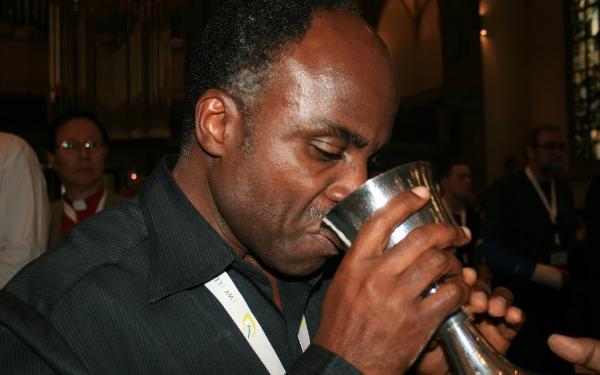‘The command that is the source and summit of Christian life is this: “Do this in remembrance of me.”’ As we celebrate on Maundy Thursday the institution of the Eucharist at the Last Supper, eminent Jesuit liturgist, J-Glenn Murray explores the way in which Black African-American worship attempts to respond to the invitation of this great command. How can the universal Church be enriched by the fruits of its local encounters with Black culture?
When Jesus walked among us in the flesh, he was not short on commands. John 15:12 records: ‘This is my commandment, that you love one another as I have loved you.’ In Luke 6:37, Christ commands: ‘Do not judge, and you will not be judged; do not condemn, and you will not be condemned. Forgive, and you will be forgiven; give, and it will be given to you.’
In Matthew, we hear that now famous set of instructions:
‘You have heard that it was said, “An eye for an eye and a tooth for a tooth.” But I say to you, do not resist an evildoer. But if anyone strikes you on the right cheek, turn the other also… You have heard that it was said, “You shall love your neighbour and hate your enemy.” But I say to you, love your enemies and pray for those who persecute you.’ (Matthew 5:38-39; 43-44).
And raised from the dead, Christ gave us his final command:
‘Go therefore and make disciples of all nations, baptising them in the name of the Father and of the Son and of the Holy Spirit, and teaching them to obey everything that I have commanded you. And remember, I am with you always, to the end of the age.’ (Matthew 28: 19-20).
But the command that is the source and summit of Christian life is this: ‘Do this in remembrance of me.’ (1 Corinthians 11:24-25; Matthew 26:26-28; Mark 14: 22-24; Luke 22: 19-20).
It is a command that we have called by many names: Eucharist, The Lord’s Supper, The Breaking of the Bread, The Holy Sacrifice of the Mass, The Holy and Divine Liturgy, The Blessed Sacrament and Holy Communion. It is command like no other, for no command has been better or more faithfully obeyed. Accomplished and engaged at dawn and at dusk, Sunday after Sunday, season after season, it is a command we have done century after century, for in doing so humanity is sanctified – made holy – and God is glorified – given thanks and praise.[1]
This command has been inculturated. From the very beginnings of the Church to this very day, inculturation in general and liturgical inculturation in particular has been not only an important concept, but an indispensable process. ‘By inculturation, the Church makes the Gospel incarnate in different cultures, and at the same time introduces peoples, together with their culture, into her own community’.[2]
Liturgical inculturation is that ‘profound interaction between local culture and the liturgy, to the point that the liturgy begins to appear not as an importation but as a reflection of the local culture, which at the same time challenges the culture to conversion’.[3] It is that process whereby the texts and the rites of the liturgy assimilate a people’s thought, language, value, ritual, symbolic and artistic pattern,[4] to such a degree that the liturgy begins to think, speak and ritualise according to local cultural pattern.
It is, consequently, a process whereby both the Church and the culture encountered are changed – whereby both are enriched.
It is this last point that is the crux of my argument. By liturgical inculturation, the Church universal is enriched by the genius of particular Churches local.
The late and great Pope John Paul II made this clear during his 1987 pastoral visit to the United States, when speaking to a group of African-American Catholics in New Orleans:
Dear brothers and sisters: your black cultural heritage enriches the Church and makes its witness of universality more complete. In a real way the Church needs you, just as much as you need the Church, for you are a part of the Church and the Church is a part of you.[5]
Recognising that there is no monolithic Black African-American religious experience and aware of any insider’s appetite for aggrandisement, let me venture, nevertheless, to propose what not a few folks and select scholars have identified as the prevailing genius and gift of Black African-American spirituality and worship style. I propose this ‘genius’ as a ‘set of attitudes.’ It is these attitudes – these interior dispositions – I posit, that might make for an exterior manifestation of full, conscious and active participation, which is the aim to be sought before all else, says the Constitution on the Sacred Liturgy.
The starting point is the notion of full, conscious and active participation itself as found in the Black religious tradition. The noted liturgist, Clarence Rivers, put it so well:
The members of a Christian religious assembly are there not merely as sponges to absorb; they are also there as witnesses of their faith and must therefore be active... In traditional Black churches, even when the congregation is listening to a soloist, or the choir singing, or the deacon praying, or the preacher preaching, they are emotionally involved participants and not passive, detached observers.[6]
Active participation is in our black bones. It is our birthright as an emotive people. Such a way of knowing is intuitive and shares the life of the Other. It is our intentional hurling ourselves into mystery.
Richard Wright speaks eloquently of how crucial this is to our being, how intentional we are: ‘Our churches are where we dip our tired bodies in cool springs of hope, where we retain our wholeness and humanity despite the blows of death’.[7] In short, we would alldo well to remember that Sunday Eucharist works best when those who are participating cannot imagine being anywhere else with anyone else. It is intentional! It echoes Saturninus and his companions before the Emperor Diocletian:
We cannot omit the celebration of the Divine Mysteries. The Christian cannot live without the Eucharist and the Eucharist without the Christian. Don’t you know that the Christian exists for the Eucharist and the Eucharist for the Christian? Yes, I participated with the brothers in the meeting, I celebrated the mysteries of the Lord and I have here with me, written in my heart, Divine Scripture. The Eucharist is the hope and the salvation of Christians.[8]
Second, preparation is another essential disposition. For those of us of colour, our preparation has been none other than that of our elders and ancestors. First and foremost, we come to our Sunday celebration from our personal prayer (devotionals). Each and every day, each one of us, alone and with family members, stands before the throne of grace and prays in these or similar words: ‘Here I stand, Lord, like an empty pitcher before a full fountain, just waiting to be filled. . . Thank you for allowing me to wake up this morning with the blood still running warm in my veins. Thank you for clothing me and putting me in my right mind.’
We come ready to witness to the wondrous deeds God has done for us, for we believe and testify that we have found meaning, freedom and understanding in our daily lives. We have found hope in Christ Jesus who liberates us now and in the future.
We come prepared for the banquet of the Lamb, dressed in our Sunday best, ready to dine on the rich fare of word and sacrament. We come in our “Sunday go to meetin’ clothes” fully aware that we are about to celebrate ‘sacred mysteries’ in the presence of a God who ‘sits high and looks low,’ the ‘God of power and might,’ the ‘fount of all holiness,’ ‘living in unapproachable light.’ This is not to deny that the God whom we approach is our ‘Father God,’ our Abba. It is simply to affirm, in our all too causal culture, that our God is still the God of ‘glory and majesty,’ our ‘all in all’! Lest anyone be deceived, it should be here noted that though this attitude is indeed manifested in our attire, it is far more in our attitude. We come prepared to bend low to be swept up.
Third, we come prepared to give, not to get – that is, to give in response to God who is the Giver of all good gifts. In our current culture, all of us are threatened by the underside of consumerism. Consequently, so is our celebration of the Sacred Liturgy. Even though some of us African Americans can be heard echoing the voice of others in our culture, our forebears knew well that we do not come simply and exclusively to get good preaching, or get rousing music, or even get Holy Communion. No, we are moved by the Spirit to do something in response to what God is doing: giving, giving, giving; saving us and setting us free in the Paschal Sacrifice of Christ Jesus. In this wondrous exchange between God and us, we are moved to give God ‘all glory and honour.’ Is this not the dream of the liturgical reformers for all of us,that we come to:
...take part in a foretaste of that heavenly liturgy which is celebrated in the holy city of Jerusalem toward which we journey as pilgrims, where Christ is sitting at the right hand of God, a minister of the holies and of the true tabernacle; we sing a hymn to the Lord’s glory with all the warriors of the heavenly army; venerating the memory of the saints, we hope for some part and fellowship with them; we eagerlyawaitthe Saviour, our Lord Jesus Christ, until he, our life, shall appear and we too will appear with him in glory.[9]
In such doing how can we not be changed and not say as of old: ‘We had Church today’? Certainly we would have, because we would have done and been Church today – this is the day the Lord has made in which we rejoice and are glad!
Fourth, another key to our full and active participation is our loving of our unique spirituality. It is a spirituality that is contemplative. African-American spirituality “senses the awe of God’s transcendence and the vital intimacy of God’s closeness.” Lifted up into God’s presence, we respond by surrendering and basking completely in marvellous mystery whether while in church on bended knee or while at home in labour or at rest.
Our genius is characteristically holistic. African-American spirituality involves the whole person: intellect and emotion, spirit and body, action and contemplation, individual and community, secular and sacred. In keeping with our African heritage, we are not ashamed of our emotions. For us, the religious experience is an experience of the whole human being, both the feeling and the intellect, the heart as well as the head. It is a spirituality grounded in the doctrine of the Incarnation – our belief that Jesus is both divine and human.
We are joyful. Our spirituality explodes in the joy of movement, song, rhythm, feeling, colour and sensation. This joy is a result of our conviction that ‘in the time of trouble, He will guide me. . . .’ This joy comes from the teaching and wisdom of our mothers and fathers in the faith.
We pride ourselves on being communitarian. The songster said succinctly, ‘We are family!’ Our worship is always a celebration of what God is doing among us. Because in this spirituality, ‘I’ takes its meaning from ‘we,’ community means social concern for human suffering as well as the cares and concerns of others.
No one would doubt that we are emotive. Whereas the European way might be summarised in Descartes’, “I think, therefore, I am,” the African model might be: “I am, I dance the Other, I am.”
We are hospitable. No matter who you are, rarely can you wander into our worshipful wonder and not be asked, ‘Who are your people?’ and made to feel welcome.
Though not often noted, it needs to be said that we are also reconciling. That we did not ‘seek an eye for an eye and a tooth for a tooth’ in response to our cruel enslavement is proof positive. Instead, we found other ways to protest our pain. One sure way was singing our song.
We are a musical people. “In Africa and America, black music was not an artistic creation for its own sake; it was directly related to daily life, work, and play. Song was an expression of the community’s view of the world and its existence in it. Through music, Africans recorded their history, initiated the young into adulthood, and expressed their religious beliefs”.[10]
This praise continues to this day. It continues for it has, too, been a long part of our heritage. Though our praising drums were taken away from us, we shouted and clapped and moaned and stomped in rhythm. Underlying all this activity was praise. That praise endures even in our own time – in the heavenly anthems of the Primal Pentecostals, the testimony of the Holiness churches, and the powerful singing of the Gospel in gospel.
And through it all our preachers sang their sermons and so stirred our souls, that we were able not only to survive but thrive.[11] Truly, singing is in our sanctified soul.
Traditionally, we are a people of kairos, a people willing ‘to waste time with the Lord.’ It is worship that does not keep its eye on the watch but on the One ‘who keeps an eye on the sparrow and watches over me.’
In the composition and delivery of prayer we have customarily employed a style that is ‘free,’ marked by a tone that is concrete, Spirit-driven, rooted in both biblical and contemporary imagery – all coming from deeply devotional and personal (private) prayer. It is a prayer that speaks of a God ‘who sits high and looks low.’ It is a prayer that is spontaneous, respecting long-established patterns of addressing God who is Almighty, the worker of wonders, as well as our need for his salvation.
It is not unlike that prayer style expressed in the document commonly known as the ‘Apostolic Tradition’. It is that prayer of which Saint Paul speaks: ‘Likewise the Spirit helps us in our weakness; for we do not know how to pray as we ought, but that very Spirit intercedes with sighs too deep for words’ (Romans 8: 26). It is a style of praying that could easily be employed in the composition of the Prayer of the Faithful; for here is a prayer that has an established pattern calling for intercessions that are both concrete and universal, expressing the ‘joys and hopes, the grief and anguish of the people of our time.’
Lastly, the genius of the black Church guides a preaching style that is concrete, speaking to the lived experiences of those assembled. It is ‘a word from the Lord’ for this people on this day. It is a style that is dialogic (the congregation responds and comments). It uses rhetorical flair, rhythm, mounting delivery, song, aphorisms and time-tested clichés. It is fearless in inciting the imagination – all the while leading the people of God to praise and to lives transformed.
Is there any parish – white or black, yellow, red or brown; urban, suburban, or rural – that could not benefit from examining itself in light of the genius and spirituality of the Black liturgical tradition? Cannot each and every parish be assisted by a celebration of the Eucharist that is contemplative, holistic, joyful, communitarian, hospitable, musical, kairotic and powerful in its prayer and preaching?
‘Full and active participation by all the people is the aim to be considered before all else,’ says Sacrosanctum Concilium, §14. I hope that this brief look at the best practice of the Black Church in the United States will be for the whole Church a source of renewal for the salvation of souls and God’s greater glory.
Fr J-Glenn Murray SJ lectures widely in the areas of Liturgy and Culture, as well as conducting parish missions and priests’ retreats. He was the principal drafter of the United States Bishops' document, Plenty Good Room: the Spirit and Truth of African American Catholic Worship. He has taught at the Jesuit School of Theology in Berkeley and his memberships include the North American Academy of Liturgy, The Catholic Association of Liturgy and the Jungmann Society.
This article is an edited version of the Second Kevin Donovan Memorial Lecture delivered at Heythrop College, University of London on 11 March 2011.
[1] See Sacrosanctum Concilium, §7, 9, 10
[2] John Paul II, Redemptoris missio, 7 December 1990
[3] Mark Francis, Shape a Circle Ever Wider, p. 64
[4] Anscar Chupungco, Liturgical Inculturation, p. 30
[5] John Paul II, ‘Meeting with Black Catholic Leadership’, 12 September 1987, New Orleans, LA, in Unity in the Work of Service (Washington, DC: USCCB Office for Publishing and Promotion Services, 1987)
[6] Clarence Rufus Joseph Rivers, This Far By Faith (Washington, DC: The Liturgical Conference, 1970)
[7] Richard Wright, 12 Million Voices: A Folk History of the Negro in the United States (New York: Thunder’s Mouth, 2002)
[8] Acts of the Martyrs
[9] Sacrosanctum Concilium, §8
[10] James Cone, The Spirituals and the Blues: An Interpretation (Seabury, 1972)
[11] See Jon Michael Spencer’s Protest and Praise: Sacred Music of Black Religion (Minneapolis: Fortress Press, 1990)






